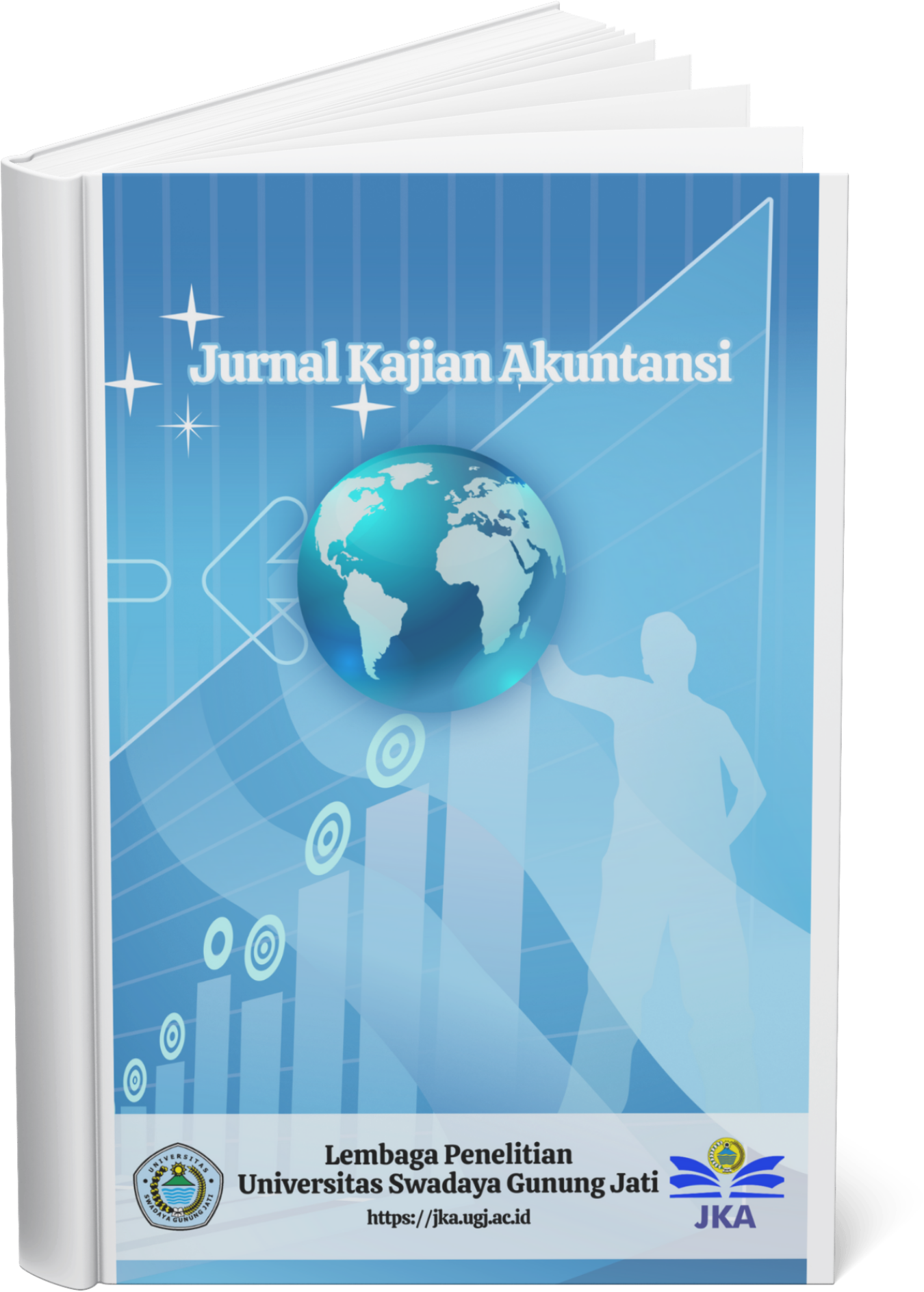Model Manajemen Risiko Saham dengan Pendekatan Risiko Sistematis dan Risiko Tidak Sistematis
DOI:
https://doi.org/10.33603/jka.v2i2.1661Abstrak
Abstract
The aim of this research was to find out the effect of systematic and unsystematic risks on the expected return of manufacture company share at the Indonesia Stock Exchange. The submitted hypothesis was that systematic and unsystematic risks had an effect on the expected return of manufacture company share at the Indonesia Stock Exchange. Analysis tool used was multiple linear regression by F test and t-test. It was used 9 samples of companies registered in the Indonesia Stock Exchange and included in LQ Indices 45 in 2014. From the calculation result of multiple linear regression analysis, it was obtained the following equation : Y = -0,054 + 0,005 X1 + 0,772 X2.It was obtained from F test result that F calculation = 7, 449. Using a significance level of 95 percent. Thus F calculation (1,803) < F, means that there was not a significant effect of systematic risk and unsystematic risk collectively on expected return. Using a significance level of 95 percent was obtained t table was 2, 1009. It was obtained from t-test result that t calculation of systematic risk (tX1) = 0,295 and t calculation of unsystematic risk (tX2) = 3,193 Thus t calculation of systematic risk was little that t table, whereas t calculation of unsystematic risk was little than t table so that partially systematic risk (X1) and unsystematic risk (X2) had no significant effect on expected return (Y).
Keyword : Systematic risk; unsystematic risk; expected return.     Â
Â
Abstrak
Tujuan penelitian ini adalah untuk mengetahui pengaruh risiko sistematis dan tidak sistematis terhadap ekspektasi return saham perusahaan manufaktur di Bursa Efek Indonesia. Hipotesis yang diajukan adalah bahwa risiko sistematis dan tidak sistematik berpengaruh terhadap return yang diharapkan dari saham perusahaan manufaktur di Bursa Efek Indonesia. Alat analisis yang digunakan adalah regresi linier berganda dengan uji F dan uji t. Digunakan 9 sampel perusahaan yang terdaftar di Bursa Efek Indonesia dan termasuk dalam Indeks LQ 45 pada tahun 2014. Dari hasil perhitungan analisis regresi linier berganda, diperoleh persamaan sebagai berikut: Y = -0.054 + 0,005 X1 + 0,772 X2. Persamaan diperoleh dari hasil uji F dimana F hitung = 7, 449 dengan tingkat signifikansi 95 persen. Dengan demikian F hitung (1,803) < F, berarti tidak ada pengaruh yang signifikan dari risiko sistematis dan risiko tidak sistematis secara kolektif terhadap return yang diharapkan. Dengan menggunakan taraf signifikansi 95 persen diperoleh t tabel adalah 2,1009. Hal ini diperoleh dari hasil uji t bahwa t hitung risiko sistematis (tX1) = 0,295 dan t hitung risiko tidak sistematis (tX2) = 3,193. Dengan demikian t hitung risiko sistematis lebih kecil dari pada t tabel, sehinggasebagian risiko sistematis (X1) dan risiko tidak sistematis (X2) tidak berpengaruh signifikan terhadap return yang diharapkan (Y).
Kata Kunci: model, manajemen risiko, saham, risiko sistematis, risiko tidak sistematis
Referensi
Abdul Halim 1995. Manajemen Keuangan, Edisi Pertama, Yogyakarta : UPP AMP YKPN
Agus Sartono. 2000. Manajemen Keuangan, Yogyakarta : BPFE
Gujarati, Damodar N. 1999. Ekonometrika dasar, Jakarta : Penerbit Erlangga
Hidayat, Rustam. (1997) Test Variabel-Variabel CAPM Sebagai Penentu Tingkat Pengembalian Saham, Usahawan N0.12 Tahun XXVI Desember, p: 24-28
Hussein Umar, 1999. Metode Penulisan Skripsi dan Tesis Bisnis, Jakarta : Penerbit Raja Grafindo
Jogiyanto H.M., 2000. Teori Portofolio dan Analisis Investasi, Edisi Kedua, Yogyakarta : BPFE
Kandel, Shmuel and Stambaugh, Robert F. (1995) Portfolio Ineficiency and The Cross-section of Expected Returns, Journal of Finance, Vol.50 No.1 March p. 157-183
Kasdjan, A. M. Z., & Nazarudin, J. Y. (2017). ANALISIS ANOMALI PASAR TERHADAP RETURN SAHAM: THE DAY OF THE WEEK EFFECT, WEEK FOUR EFFECT, DAN JANUARY EFFECT. Jurnal Kajian Akuntansi, 1(1), 35-44.
Klemkosky, Robert C and Martin John D. (1975) The Effect of market risk on portfolio diversification, The Journal of Finance , Vol.XXX ISS :1 Mar p.147-154
Marston, Felicia and Harris, Robert S. (1993) Risk and Return : A Revisi using expected returns, Financial Review (FRV) ISSN: 0732-8516 Vol.28 ISS:1 Feb p : 117-137
Mayasari, T., & Yulianto, A. (2018). Pengaruh Return on Equity, Net Profit Margin dan Ukuran Perusahaan Terhadap underpricing. Jurnal Kajian Akuntansi, 2(1), 41-53.
Mohammad Muslich,1997. Manajemen Keuangan Modern, Jakarta: Penerbit Bumi Aksara
Purwohandoko. (1999) Studi Empirik Hubungan Antara Tingkat Keuntungan Yang Diharapkan Dengan Beta Atas Saham yang Diperdagangkan Pada Bursa Efek Jakarta Pendekatan Capital Asset Pricing Model, Tesis Program Pascasarjana Universitas Brawijaya Malang
Singgih Santoso, 2000. SPSS 10, Jakarta : Elexmedia Komputindo
Suad Husnan. 1996. Dasar-dasar Teori Portofolio dan Analisis Sekuritas, Edisi ketiga, Yogyakarta : UPP AMP YKPN
Supranto, J. 2001. Statistik Teori dan Aplikasi Jilid 2, Jakarta : Penerbit Erlangga
Weston J. Fred dan F Brigham Eugene 1994. Dasar-Dasar Manajemen Keuangan, Edisi Sembilan, Jakarta : Erlangga
Vanhorne James C dan Wachowicz, Jr, John M. 1997. Prinsip-Prinsip Manajemen Keuangan, Edisi Sembilan, Jakarta : Salemba Empat
Unduhan
Diterbitkan
Cara Mengutip
Terbitan
Bagian
Lisensi
- Authors retain copyright and grant the journal right of first publication with the work simultaneously licensed under a Creative Commons Attribution-ShareAlike (CC-BY-SA 4.0) that allows others to share the work with an acknowledgment of the work's authorship and initial publication in this journal.
- Authors are able to enter into separate, additional contractual arrangements for the non-exclusive distribution of the journal's published version of the work (e.g., post it to an institutional repository or publish it in a book), with an acknowledgment of its initial publication in this journal.
- Authors are permitted and encouraged to post their work online (e.g., in institutional repositories or on their website) prior to and during the submission process, as it can lead to productive exchanges, as well as earlier and greater citation of published work.
